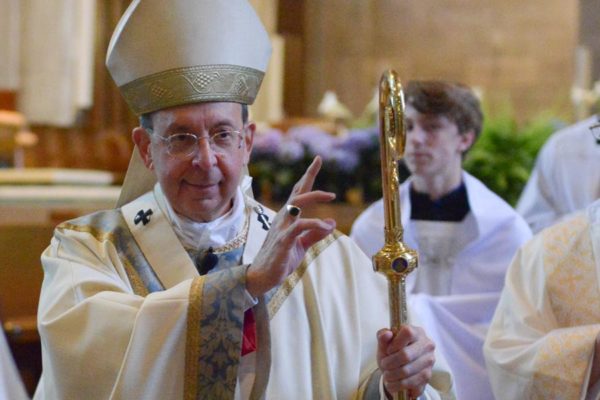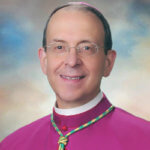Solemnity of the Presentation of the Lord in the Temple
Knights of Columbus Board Meeting
North Miami Beach, Florida
Feb. 2, 2019
Introduction
I’m not qualified to be a movie critic but I know this much. When a film is good, it engages us – body, mind, and spirit. If it’s well-written, produced, and directed, if the sound, the scenery, and special effects are skillfully executed, and, above all, if the actors are well-cast and convincing – if all of that and more happens – we find ourselves drawn into a world that only cinema can create. We not only accept the movie’s premises – even suspending our normal powers of reasoning and belief – but we also enter into the story line to such a degree and with such intensity that we ourselves become actors in the unfolding drama . . . And not merely actors who mimic the stars . . . but rather participants . . . participants who understand what the unfolding drama means, why it touches the heart, opens the mind, and changes the world, for weal or for woe.
Could there be anything more engaging than the drama that unfolds before our eyes of faith on this, the feast of the Lord’s Presentation in the Temple? This scene was not created by a playwright or a producer but rather by the One “for whom and through whom all things were made.” It opens some 400 years before the birth of Christ, in the Temple, the place where the hopes of the people chosen by God were concentrated. God’s messenger, Malachi, announces that suddenly, after centuries of waiting, the long-expected Lord and Messiah would enter the Temple. The prophet announces the awe-inspiring arrival of the One who will purge the sons of Levi, that is, the priestly caste, of their sins and refine them just as impurities are extracted from silver and gold. Malachi prepares us, or so we think, for the entry of a prince or a warrior who will reform God’s People so as to restore their former glory.
The scene then shifts – We are still in the Temple but a Temple being rebuilt after years of strife. There we encounter neither a prince nor a warrior but a little Child, some forty days old, carried in his Mother’s arms, a Child brought into the Temple for the customary rites of purification. Mary and Joseph appear in all their poverty, humility, and obedience, a young and utterly innocent Mother, holding her Child, and a husband, strong in his silence, unshakeable in his faith. At the center of this scene is the Child. We ask: Could this Baby be the long-awaited Messiah foretold by Malachi?
Then there is Simeon in his old age, a man named for one of Jacob’s sons, a layman, wizened by years of hard work and prayerful expectation. His eyes grow dim but not his spirit, as with other devout people he awaits Israel’s redemption, the consolation promised by the prophet Isaiah. Others awaited the Messiah but it was to Simeon alone that the Holy Spirit had confided that he would not see death until he laid his eyes upon the Messiah of God. Moved by the Spirit, he goes to the Temple, holds in his arms the Child of the Promise. And what lines he was inspired to utter, words etched in his heart by the Holy Spirit: “Now, Lord, you may dismiss your servant, you may let me die in peace – because I have seen the Savior, the light of the world, the glory of Israel” – a light that will illuminate even the darkest of souls – “Maybe even mine,” we think! Simeon tells the Baby’s mother that her Son, Jesus “. . . is both a light that shines . . . and at the same time a sign of contradiction” to those who will oppose him and his mission. Then from the shadows the widow Anna emerges, like Simeon, in her advancing years and longing for the promised deliverance. Both speak for and embody Israel’s deepest hopes and aspirations.
Who could craft or cast such figures but God the Father in the Holy Spirit? No one else would have either the imagination or audacity to do so. Yet, to the uninformed or faithless observer, maybe even for us who see dimly, as in a mirror (1 Cor. 13:12), the scene so skillfully created remains somehow opaque, too much to comprehend. So it is that the divine playwright provides us with a narrator to guide us through the scene, namely, the author of the Letter to the Hebrews. He it is who explains why Jesus was submitted to ritual purification – not because he was sinful as we are, because it is the Father’s plan that our Redeemer be like us in every way but sin, and that he stand in solidarity with our frailty. It is his plan that our Redeemer blaze a path through the thicket of our sins unto glory. When the author of Hebrews says that “Jesus had to be made perfect by suffering”, he shows us how Jesus fulfills Malachi’s prophecy of a mighty Savior who would cleanse the people of their sins. He did so by taking upon himself our fallen state with its weakness, pain, & death. “In enduring the Passion, Jesus allowed the evil unleashed upon him to bring forth the most perfect act of love, trust, and obedience to God that could ever come from the human heart” (Fr. Pablo Gadenz, Catholic Commentary, Gospel of St. Luke, p. 62).
Actors in the Drama of Our Salvation
What we are witnessing in this liturgy is more than a humanly crafted drama. To the contrary, we are at the heart of the central drama of human history, the plan authored by the Triune God to save us and to save the world. If we do not sit by passively for a skillfully created human drama, how can we keep from participating – body, mind, and spirit – in the central drama of all life and all history? Does not our liturgy place us in the midst of this scene where Christ enters the Temple to purify not himself but the world?
Therefore, let us approach these mysteries of our salvation with the spirit of poverty, humility, and obedience of Mary, the Mother of Jesus. Let us, like Joseph, remain strong in our faith and reverent in our silence at the threshold of a love and mercy that exceeds our capacity to comprehend. As we enter upon the One Sacrifice by which we and the world are purified, may our heart, like Mary’s be pierced by the sword of sorrow, as we offer to God the Body, Blood, Soul, and Divinity of his beloved Son, Our Lord Jesus Christ, in atonement for our sins and those of the whole world.” (Chaplet of Divine Mercy) As we receive Christ into our hands and our hearts, may we behold the Savior whom Simeon once held in his arms, the Messiah for whom he longed. Would that our longing for Jesus would be something like that of Simeon! Would that our lives might proclaim this Savior to be the light – the light that illumes our souls, the light of knowledge, the light of faith, “the light that guides us through the shadows of death unto the way of peace” – And what if we beheld Jesus with the lively faith and prayerfulness of Anna. Just as Anna embodied the hopes of the Chosen People, so may we live in this passing world with our heart set on the world that is to come.
And so we pray: Just as the Father’s only-begotten Son once was presented in the Temple in the substance of our flesh, so by his grace may we be presented to God with minds made pure and hearts filled with joy. Vivat Jesus!


